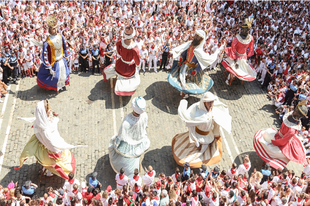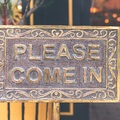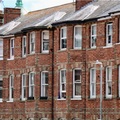
Culture and art add aesthetic value to our lives. Cultural events, exhibitions, concerts are ways how people spend their free time. Art is a way of communicating feelings. Artists express themselves in many ways, so they create different opuses in many fields.
According to these fields you can enjoy arts at different places such as museums, art galleries, theatres, cinemas, concert halls, churches, castles etc. Artist are people who are gifted in arts, like actors, musicians, conductors, composers, painters, sculptors, writers and poets. There are not only artists, but there are people who enjoy their creations. A third group of people are critics, whose main task is criticising.
Cultural events in rural areas are not very frequent, but in many villages exist so-called houses of culture which are the centre of cultural life. Villages also hold so-called village days annually. Folklore is important in a certain folk's life. Traditions, folkways, folk songs are parts of the culture as well. Nowadays people prefer watching a movie to reading a book. It doesn't consume so much time and tickets are even cheaper than a book itself. A movie based on a book usually isn't better, than its foundation but many people prefer these. Actors, actresses, film directors and script writers are artists, too.
Fields of arts:
- literature - novels, short stories, drama, biography, poetry
- performing arts - dance, ballet, opera, theatre, cinema
- music: classical, rock, jazz, country, music, pop, folk music
- fine arts / visual art - paintings – portraits, landscapes, still life,
- drawings, graphic art, poster, graffiti art, photos
- sculpture – statue, monument, memorial, bust, ceramics
- architecture - buildings such as castles, palaces, churches, cathedrals, etc.
- performing arts
- music, opera, dance, ballet, theatre, concerts
Music is a hobby, a profession and the part of some people's lifestyle. It accompanies us in our entire life. Mothers sings to their babies some lullabies, on their way to school kids have their headphones on and listen to their favourite music, their parents sing along with the radio in their car. There are different types of music:
- classical music (Beethoven, Mozart)
- opera (Carmen, Nabuco)
- rock, pop, jazz, blues, country, folk songs, reggae, rap, gospel, hip-hop, metal etc.
Dramatic art
theatre - theatregoers can enjoy live performances, they can watch drama, comedies, tragedies or a musical.
cinema - films are shown on the screen, they can have subtitles or may be dubbed. To improve the atmosphere of the films, the producers use a lot of special effects (music, sound, light, voices, 3D effect, stunts). Excellent films win an Oscar at the film festival (actors are often awarded an Oscar for an excellent performance, the opposite to the Oscar is Golden Raspberry award, which is given to the worst actor in a film).
Literature
Literature is the art of writing. Among literary opuses are some novels, novellas and short stories, but also biographies and memoirs can be regarded as part of cultural heritage. It is said that writing requires some kind of writing talent, therefore it is the art of creating sentences, paragraphs and even non-existing worlds. Some of the most popular literary pieces include writings of Agatha Christie, Charles Dickens or William Shakespeare.
Architecture
In the past people used to build splendid buildings to show the importance and wealth of their owners. Some places are rich in castles, churches, cathedrals, others are rich in pyramids, towers and bridges. The modern age brings two extremes: extravagance and simplicity. Both creativity and effectiveness are combined by architects.
Sculpture
An artist who makes sculptures is called a sculptor; he usually displays his statues/busts in visible places – town centres, shopping malls etc. They are important part of public art. Sculptures are made of wood, ceramics, stone, glass or metal. Sculptures were mainly represented in religious sphere (in churches and cathedrals) in the past. However, sculptures which are outside can be easily damaged either by people (vandalism) or bad weather conditions (acid rain etc.)
Painting
People say that visiting galleries and museums is only for the older people. Of course, it takes some time to go through the place and see all the paintings. It requires patience and some knowledge if you want to admire what is displayed. The paintings may vary from the abstract paintings through sceneries, portraits such as Mona Lisa. Nowadays, body painting and tattoo are quite popular among young people.
Graffiti
Graffiti is a writing or drawing that is scribbled, scratched or sprayed on a wall or on other surfaces (often in a public place). Even simple words can be elaborated wall paintings.
Tattoo
Some people consider it as art, however, for the others it is just a self-destructing activity. People with tattoos all over their bodies occur more and more frequently. Their tattoos attract our attention, and the reactions vary from the positive (independent, creative, trendy, tough) to the negative ones (crazy, absentminded). In the past, tattoos have been used as a social-branding signs.
PLACES
In arts we distinguish various styles such as classical, romantic, impressionist, modern or abstract. The most fabulous pieces of arts are called masterpieces. The authors are called artists – sculptors, painters, photographers.
Traditionally, they use places like museums, galleries for their exhibitions. However, modern artists use even bridges, train stations, town centres to display their art, to show the art to an ordinary person coming from work.
- art gallery – we can see there exhibitions of classical or modern art (e.g. exhibitions of photographs, paintings, sculptures, book illustrations etc.)
- museum – we can learn there about the history of a country or about the history of the whole world. You can see also exhibitions of things which show us how people lived in the past.
Young people like going to:
- cinema – to watch movies
- concerts – young people usually prefer pop concerts to classical concerts. Pop concerts are usually held in summer at sport stadiums
- music festivals – are held mainly in summer and they are attended by many people
| value – érték exhibition – kiállítás opus – mű performing arts – előadóművészet fine arts – képzőművészet architecture – építészet theatre – színház cinema – mozi concert hall – koncertterem to be gifted – tehetséges conductor – karmester annually – évente folkways – népszokások to accompany – kísérni, velejár (velejárója vminek) lullaby – altatódal performance – előadás, teljesítmény subtitled – feliratozott dubbed – szinkronizált stunt – mutatvány splendid – pompás effectiveness – hatékonyság sculptures – szobrok scenery – tájkép bust – mellszobor bad weather conditions – rossz időjárási körülmények self-destructing – önpusztító to vary – váltakozik scribbled – odafirkantott scratched – karcolt surface – felület elaborated – kidolgozott social-branding sign – társadalmi megkülönböztetés szimbóluma to distinguish – megkülönböztetni fabulous – mesés, legendás ordinary person – közönséges ember open-air theatre – szabadtéri színház |






